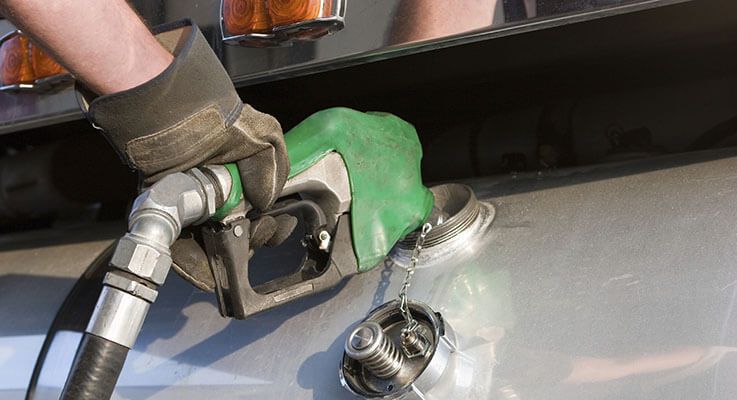Blog

Expert Tips to Manage Semi Truck Fuel Economy
General
Owning a semi truck can be overwhelming, especially when you consider the dedication required to get the most out of your investment. In addition to many challenges you are faced with as a truck owner, fuel economy is another important thing that must not be overlooked if you want to get a good ROI. In most cases, a semi truck fuel capacity is about 150 to 300 gallons; therefore, filling up a truck with enough diesel for a long distance haul can run over a thousand dollars. Without a doubt, fueling your truck is one of the things that cost you the most.
Although you can neither lower your semi truck fuel capacity nor stop it from consuming fuel, there are still many things you can do to enhance the fuel efficiency of your truck and lower the amount you have to spend on fuel. Various truck drivers have tested these methods of improving the fuel economy of semi trucks, so there is no doubt about the effectiveness of these practices.
Are you ready to enhance your semi truck fuel economy? Here are the things you need to do to achieve this:
Drive with the Mindset of Improving Semi Truck Fuel Economy
When it comes to determining the amount of fuel that a semi truck consumes during each journey, drivers play pivotal roles. Therefore, driver education goes a long way in managing the fuel economy of semi trucks. With the aid of a proper and practical driver training program, there can be as much as 5 to 10% improvement in fuel economy.
Experienced and trained drivers can save anywhere from $1,200 to $2,400 on fuel each year through proper driving. When you consider the amount that will be spent on maintenance and other essential things, improving the fuel economy of semi trucks can make a big difference in your overall profit at the end of the year.
However, to achieve any form of improving semi truck fuel mileage, initiating a driver training program is essential. So, what are the techniques that driving training programs will teach you to improve the fuel economy of your semi trucks? These fool-proof methods you can use include:
- Avoid driving your semi truck with engine RPM that is too high
- Reduce frequent or inappropriate shifting
- Reduce acceleration on the road
- Avoid numerous starts and stops
- Make use of cruise control only when necessary
- Accelerate and brake gradually, smoothly and adequately
- Lower the amount of time you have your truck idling
- Coast whenever it is possible and appropriate
- Ensure block shifting when appropriate
- Avoid shifting when possible
- Avoid the use of cab accessories so that energy losses are significantly reduced
- Start driving at a gear that does not need applying through before the clutch is released
- If your trucks are being used for urban services, the fuel efficiency can be even improved further as shifting practices will be beneficial to the fuel economy in the long run.
Keep Track of Your Speed
Your driving speed as it relates to your semi truck fuel economy can never be overemphasized. The rigors involved with driving every day over a long distance can be genuinely excruciating. Therefore, it is very likely that you will want to drive faster so that you can be finished with your haul on time. Nevertheless, doing so comes with lots of cons, and one of them is spending too much money on fuel.
Let's put how the driving speed affects the fuel economy of semi trucks into perspective so that you can have a better understanding. Basically, for every increase of 1 mph in speed, an average of 0.14 miles per gallon is reduced in the semi truck fuel economy.
Let us assume that your semi truck goes as much as 2,500 miles each week. However, you feel it is vital for you to save time for whatever reasons. So, your average speed is increased by 10 mph. If your truck is an 18-wheeler, your average fuel economy will be around 5.9 mpg; however, increasing the speed will reduce the fuel economy to 4.5 mpg.
From the above example, your truck will require 132 gallons of diesel as a result of the 10 mph increase in the speed. These extra gallons of fuel will cost you about $400 in just a week. If the semi truck covers the same distance at the same speed in one month, you would have spent an additional $2,000 for increasing the speed by only 10 mph. Justifying such an outrageous waste of money will be difficult.
Now That You Know Your Speed Can Have a Significant Effect on Your Fuel Economy, What Can You Do to Manage It?
- Slow down your driving speed intentionally. It may take time before you get used to it but it will be worthwhile
- Get an Electronic Control Module and use it to restrict the speed of your semi truck through its road speed limiter
Use Electronic Engine Monitors
Sometimes, keeping all the methods in mind can be tasking as you may have many other issues going on with you that you are thinking about. Fleet owners can take advantage of electronic engine monitors to the operating patterns of their drivers and understand whether the drivers have done well in getting more out of their semi truck fuel capacity. These electronic engine monitors measure the performance of each driver over a period. A benchmark will be determined to know the drivers that have done well during this period or otherwise.
Fleet owners can encourage their drivers to drive effectively to improve the fuel economy of semi trucks by providing incentives to those that performed well over the period measured. Such incentive-based programs will not only reward good drivers, it will also motivate each driver to be conscious of how they drive for better fuel efficiency. If properly applied, the amount that will be recouped through the improvement of semi truck fuel economy of a whole fleet will be way greater than the incentives given to the truck drivers.
Reduce Idling of the Engine
Idling the engine is a common way to control the cab environment when you are parked. However, idling can have a negative effect on the fuel economy of your truck. For an average truck that goes on a long haul, idling happens for about six hours or more each day for over 250 days every year. Considering the amount of fuel that would be wasted during the idling period, fleet owners would likely waste as much as $6,000 on fuel each year. Therefore, reducing the rate of idling in your semi trucks can save you lots of money.
Fleet owners can save money on their semi trucks by establishing a policy that bans idling by their drivers. Apart from positively impacting fuel economy of semi trucks, this policy will also reduce the health risks associated with idling for drivers, lower the cost of maintenance, and increase the engine life of a semi-truck. There is a lot to gain from reducing the rate of idling of a semi truck through policy implementation. Nonetheless, if such policy cannot be instituted, fleet owners can monitor the idling time of their truck drivers and provide incentives to those whose idling time is low.
Fleet owners and truckers alike can reduce idling of their engines using these methods and devices:
Acquire a direct-fired heater. It is a lightweight device that can be taken anywhere to get heat. With this portable device, drivers do not have to idle the engines of their semi trucks; hence, they can get the most out of their semi truck fuel capacity without reducing their fuel efficiency.
Use truck stops that make use of the electrical system of your truck to provide heat when needed. Truck stop electrification technology can work alone, so there is no need for the engine to be idling. Although different manufacturers offer this technology in various forms, they are all capable of preventing the need to idle your engine.
Use an automatic engine start-up/shutdown system to manage the engine. Through this system, the engine of the truck can be stopped or started automatically based on the temperature and other factors. For instance, the system can be set to start the engine automatically whenever the temperature outside is below a specific degree. This reduces the idling time of the engine and saves fuel.
Install auxiliary power generating sets in the semi truck. These generating sets are diesel-powered engines that are designed to offer heat and other things, so they can be utilized to stop idling of the engine. Apart from providing heat, these auxiliary power generating units offer air conditioning and electrical power required to run appliances and lights.
Keep Track of Tire Pressure
In many situations when tires are inflated improperly. An improperly inflated tire does not only affect the health of your truck, but it also decreases semi truck fuel economy and makes you lose more money on fuel. To monitor the pressure of the tires, routinely check the tires. If any of them are improperly inflated, take care of it. You can add or remove air from the tire based on its condition.
Furthermore, if you notice that any of the tires have been losing air frequently, do not hesitate to repair it. If the problem persists after repair, it is time you replaced the damaged tire to save money you will be spending on fuel.
Use the Right Tires
Approximately 13% of energy use by a truck goes to tire rolling resistance; therefore, using the right tire will lower rolling resistance; thus, saving a lot of money on fuel consumption of the truck. Instead of using two standard tires and wheels, you should go for a single wide-base tire and wheel. Due to the total weight savings of a semi truck that can be as much as 1,000 lbs, fuel consumption will reduce significantly.
When compared to two standard tires or other alternatives, single wide-base tires can improve the fuel economy of semi trucks by as much as 5%. Despite the advantages of single wide-base tires and wheels concerning fuel economy, they cost less than two equivalent dual tires and wheels. So, by using single wide-base tires and wheels, you will pay less to buy them and also save money by improving the fuel economy of your truck.
Reduce the Weight of the Truck
It's crucial for you to understand that you will have to spend more on fuel if your truck is heavy because accelerating and climbing hills will demand more energy. In other words, the heavier the truck, the higher the amount of fuel required to power it to accelerate and climb. Therefore, if you can reduce the weight of your truck, you can subtly increase the semi-truck fuel economy.
When choosing tractor and trailer components, you should go for those that are lightweight as they are capable of lowering the weight of your truck by up to 3,000 lbs. This reduction in the weight of the truck is capable of saving as much as 500 gallons of fuel each year. That is, you can save about $1,300 every year by just reducing the weight of the truck.
What are the replacement options you can explore to reduce the weight of your semi truck? These options include:
- Aluminum axle hubs – they are capable of reducing the weight of your semi truck by 120 lbs
- Aluminum clutch housing – when compared to iron clutch housing, this alternative can reduce the weight of a truck by 50 lbs
- Cast aluminum alloy wheels – each of them can reduce the weight by about 40 lbs
- Centrifuse brake drums can reduce the weight of the truck by 100 lbs
- Aluminum cab frames can reduce the weight by more 100 lbs
- Downsizing the standard engine of a truck to smaller, lighter-weight ones can reduce the weight by more than 700 lbs
- Composite front axle leaf springs can lower the weight of the truck by more than 70 lbs
- Aluminum floor joists reduce the weight by 300 lbs
- Aluminum hubs and wheels can reduce the weight by 900 lbs
- Aluminum upright posts reduce the weight by 600 lbs
- Aluminum roof posts lower the weight by 75 lbs
- All these alternatives for lowering the weight of your truck will save you thousands of dollars on fuel at the end of the year.
Utilize Low-viscosity Lubricants
Many drivers do not realize that the impact of lubricants on their semi trucks goes beyond merely reducing friction and wear of the transmission, drivetrain, and engine of their trucks; it extends to improving the fuel economy. When compared to the conventional lubricants, low-viscosity lubricants have been known to offer less resistant to flow; hence, they are capable of lowering friction and loss of energy. These same low-viscosity lubricants are important to the fuel economy of a truck.
Reports have shown how synthetic engine and transmission lubricants are capable of increasing fuel economy by at least 5%. Even at lower speeds, the improvement can be greater. Synthetic transmission and axle lubricants could provide 2% improvement to fuel economy in the winter and 0.5% improvement in the summer due to the difference in the temperature during these seasons. About 3% increment could be experienced in semi-truck fuel economy if synthetic gear lubricants are used.
Truly, conventional lubricants cost only about half of the price of semi-synthetic and synthetic lubricants. However, lubricants are not required by the trucks every day; so you are going to save a lot more on the fuel economy. Also, the ability of low-viscosity to reduce friction in components can save you money on maintenance is worth considering too.
Consider Getting Hybrid Trucks
If you want to buy a new truck or you have plans to change your old one, you should consider purchasing a hybrid truck. These trucks are powered with hybrid powertrain technology which improves the efficiency of their engines.
A hybrid truck usually has an additional propulsion power source that provides extra power required to accelerate or climb hills. The primary propulsion power source has the opportunity to function at its highest level and, thus, fuel economy is increased. So getting a hybrid truck is a fantastic idea that can make a big difference in the fuel economy.
These types of semi trucks are recommended for fleets whose operations are within urban areas. Utility trucks, parcel delivery vehicles, refuse trucks and other trucks that are designed for stop-and-go applications can also benefit from hybrid powertrain technology.
Avoid Rapid Acceleration
When you accelerate a truck rapidly, a strain is placed on the engine of the truck and this, in turn, leads to wasting fuel. Therefore, if you want to increase your semi truck fuel economy, do not accelerate rapidly.
Manage Your Logistics Effectively
Whether you realize it or not, your freight operations affect your fuel economy. When your logistics are not well managed, you have to use your truck longer, idle regularly, travel empty and move through congested routes regularly. These will lead to an increase in the fuel consumption of your truck. An average long-haul truck could consume an extra 2,400 gallons of fuel in a year as a result of non-revenue empty miles accumulated as a result of poor logistics.
Managing your freight operations on your own may be ineffective or too strenuous; so utilize computerized routing and scheduling software. This software has been designed to use all necessary parameters to assist you in constructing the right route. These parameters include equipment availability, pickup schedule, delivery schedule, driver hours-of-service rules, route restrictions, vehicle size constraints, empty mileage, vehicle-loading dock compatibility, and vehicle-product compatibility.
If you would like to avoid traffic congestion, you can consider hauling at off-peak times. No matter where you are delivering any goods, 24/7 shipping and receiving services are available in most places, so you can deliver the products at any time. So, you can avoid or reduce idling and other factors that adversely affect the semi-truck fuel economy by managing your logistics.
Improve the Aerodynamics of Your Truck
Another way to improve the fuel economy of your truck is to manage your aerodynamics. You should understand that wind resistance influences the energy loss of your truck; hence, if you can lower your drag coefficient, you can reduce the fuel consumption of your truck.
A few options to improve the aerodynamics of your truck include:
- Side fairings — to lower the air flow under the semi truck
- Cab extenders — to bridge the gap between the trailer and the tractor significantly
- Front bumper air dam — to lower the airflow under the truck
- Roof fairings — many truck manufacturers are already producing trucks with improved aerodynamics that have a sloped hood, streamlined front profile, and other devices. Such aerodynamic semi trucks may be able to save fuel consumption by as much as 15%. Therefore, getting trucks with improved aerodynamics is an excellent idea for improving the fuel economy of semi trucks.
Conclusion
Like many other activities, increasing the fuel economy of semi trucks requires determination and readiness to pay attention to and utilize these important tips for truckers. Remember that every dollar counts when you want to optimize your profits and make your investment in buying a semi truck worthwhile. Therefore, be patient, learn and continue to apply the methods mentioned above to improve the fuel economy of your truck and save yourself thousands of dollars.

Noel Ballon
Noel Ballon is a skilled personal finance writer passionate about helping people to succeed financially.
As a guest writer for CASH 1, Noel has shared his knowledge on a variety of financial issues, including budgeting, saving, investing, and retirement planning
Noel has a background in economics and finance with over five years of experience writing in the financial sector.
He works to simplify complicated financial ideas so that people from every area of society may understand them.
When Noel isn't writing, he likes keeping current on the latest financial sector changes and looking for fresh approaches to assisting people in choosing wise financial decisions.





